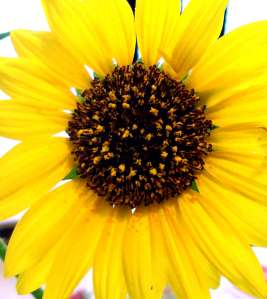 It’s been held that the sunflower was originally domesticated in eastern North America then introduced to Mexico -the sunflower is a major seed crop in the world when it comes to obtaining oils. But recent evidence suggests very strongly that it may have been the other way around.
It’s been held that the sunflower was originally domesticated in eastern North America then introduced to Mexico -the sunflower is a major seed crop in the world when it comes to obtaining oils. But recent evidence suggests very strongly that it may have been the other way around.
Shells of sunflower seeds (called achenes) were found in a dry cave in Mexico (Cueva del Gallo) which dated to about 300 BCE. Cueva del Gallo was used in antiquity as a ritual center -caves were thought to be the passages the sun used to travel the underworld from the west only to rise again from the east, so this may hold some significance that sunflower seeds were found. As David Lentz, of the University of Cincinnati, writes in his paper at PNAS, Sunflower (Helianthus annuus L.) as a pre-Columbian domesticate in Mexico, “the modern O tomi word for sunflower, dä nukhä, trans lates to “big flower that looks at the sun god.‒
The cave presented a dessicated environment that preserved the shells in “pristine condition,” but the Cueva del Gallo shells weren’t the oldest found. That prize goes to a water-logged site at San Andrés where accelorator mass spectrometry dates sunflower remains to older than 2600 BCE! This puts the sunflower in Mexico as a probable domesticated crop far earlier than was previously believed. It was thought that the Spaniards brought the crop and that it was originally cultivated in North America. Now, the questions arise: did cultivation of the sunflower begin in one place then get introduced to another through trade. Corn made its debute in North America via trade from Mesoamerica northward -perhaps the same happened with the sunflower.
If your university library has access to all of PNAS or if you’re willing to pay the fee (or already subscribe) you can get the full paper by Lentz, et al, at this link. If not, here’s the abstract, also available at the same link:
Mexico has long been recognized as one of the world’s cradles of domestication with evidence for squash (Cucurbita pepo) cultivation appearing as early as 8,000 cal B.C. followed by many other plants, such as maize (Zea mays), peppers (Capsicum annuum), common beans (Phaseolus vulgaris), and cotton (Gossypium hirsutum). We present archaeological, linguistic, ethnographic, and ethnohistoric data demonstrating that sunflower (Helianthus annuus) had entered the repertoire of Mexican domesticates by ca. 2600 cal B.C., that its cultivation was widespread in Mexico and extended as far south as El Salvador by the first millennium B.C., that it was well known to the Aztecs, and that it is still in use by traditional Mesoamerican cultures today. The sunflower’s association with indigenous solar religion and warfare in Mexico may have led to its suppression after the Spanish Conquest. The discovery of ancient sunflower in Mexico refines our knowledge of domesticated Mesoamerican plants and adds complexity to our understanding of cultural evolution.
Personally, I find research into early domestication of crops and animals to be fascinating. I’m convinced that much of early domestication is related to religious and cult activity, some of it perhaps even because of it. Sun gods, fertility godesses, and the deities that people in antiquity assigned to the natural world created an intricate system of beliefs and rituals as they sought to appease imagined gods in order to bring about favorable conditions for subsistance. Indeed, and according to Lentz, et al, demise of the sunflower until its reintroduction at a later date by the Spanish was probably due to the power it held as a symbol for ritual use in pagan religion. Spanish preists were notorious for obliterating native culture and religion as they sought to convert indigenous Mesoamericans to Catholism.
Leave a Reply
You must be logged in to post a comment.